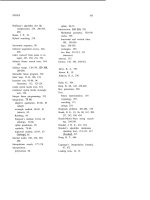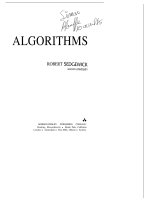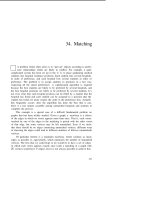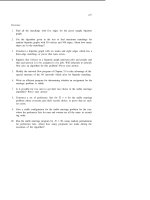Tài liệu Thuật toán Algorithms (Phần 8) pdf
Bạn đang xem bản rút gọn của tài liệu. Xem và tải ngay bản đầy đủ của tài liệu tại đây (114.04 KB, 10 trang )
GAUSSLAN
63
Obviously a “library” routine would check for this explicitly.
An alternate way to proceed after forward elimination has created all
zeros below the diagonal is to use precisely the same method to produce all
zeros above the diagonal: first make the column zero except for a[N, N]
by adding the appropriate multiple of N], then do the same for the
to-last column, etc. That is, we do “partial pivoting” again, but on the other
“part” of each column, working backwards through the columns. After this
process, called Gauss- Jordan reduction, is complete, only diagonal elements
are non-zero, which yields a trivial solution.
Computational errors are a prime source of concern in Gaussian elimina-
tion. As mentioned above, we should be wary of situations when the mag-
nitudes of the coefficients vastly differ. Using the largest available element
in the column for partial pivoting ensures that large coefficients won’t be ar-
bitrarily created in the pivoting process, but it is not always possible to avoid
severe errors. For example, very small coefficients turn up when two different
equations have coefficients which are quite close to one another. It is actually
possible to determine in advance whether such problems will cause inaccurate
answers in the solution. Each matrix an associated numerical quantity
called the condition number which can used to estimate the accuracy of
the computed answer. A good library subroutine for Gaussian elimination
will compute the condition number of the matrix as well as the solution, so
that the accuracy of the solution can be lknown. Full treatment of the issues
involved would be beyond the scope of this book.
Gaussian elimination with partial pivoting using the largest available
pivot is “guaranteed” to produce results with very small computational errors.
There are quite carefully worked out mathematical results which show that the
calculated answer is quite accurate, except for ill-conditioned matrices (which
might be more indicative of problems in system of equations than in the
method of solution). The algorithm has been the subject of fairly detailed
theoretical studies, and can be recommended as a computational procedure
of very wide applicability.
Variations
and Extensions
The method just described is most appropriate for N-by-N matrices with
most of the elements non-zero. As we’ve seen for other problems, special
techniques are appropriate for sparse matrices where most of the elements are
0. This situation corresponds to systems equations in which each equation
has only a few terms.
If the non-zero elements have no particular structure, then the linked
list representation discussed in Chapter is appropriate, with one node for
each non-zero matrix element, linked together by both row and column. The
64
CHAPTER 5
standard method can be implemented for this representation, with the usual
extra complications due to the need to create and destroy non-zero elements.
This technique is not likely to be worthwhile if one can afford the memory to
hold the whole matrix, since it is much more complicated than the standard
method. Also, sparse matrices become substantially less sparse during the
Gaussian elimination process.
Some matrices not only have just a few non-zero elements but also have
a simple structure, so that linked lists are not necessary. The most common
example of this is a “band)) matrix, where the non-zero elements all fall very
close to the diagonal. In such cases, the inner loops of the Gaussian elimination
algorithms need only be iterated a few times, so that the total running time
(and storage requirement) is proportional to N, not
An interesting special case of a band matrix is a “tridiagonal” matrix,
where only elements directly on, directly above, or directly below the diagonal
are non-zero. For example, below is the general form of a tridiagonal matrix
for N =
0 0 0
0
0 0
For such matrices, forward elimination and backward substitution each reduce
to a single for loop:
for to N-l do
begin
end ;
for j:== N 1 do
j];
For forward elimination, only the case and needs to be included,
since for (The case k =i can be skipped since it sets to 0
an array element which is never examined again -this same change could be
made to straight Gaussian elimination.) Of course, a two-dimensional array
of size wouldn’t be used for a tridiagonal matrix. The storage required for
the above program can be reduced to be linear in N by maintaining four arrays
instead of the a matrix: one for each of the three diagonals and one
for the (N column. Note that this program doesn’t necessarily pivot on
the largest available element, so there is no insurance against division by zero
GAUSSIAN
65
or the accumulation of computational errors. For some types of tridiagonal
matrices which arise commonly, it can be proven that this is not a reason for
concern.
Gauss-Jordan reduction can be implemented with full pivoting to replace
a matrix by its inverse in one sweep it. The inverse of a matrix
A, written has the property that a system of equations Ax = b could
be solved just by performing the matrix multiplication = Still,
operations are required to compute x given b. However, there is a way to
preprocess a matrix and “decompose” it into component parts which make
it possible to solve the corresponding system of equations with any given
side in time proportional to a savings of a factor of N over
using Gaussian elimination each time. Roughly, this involves remembering
the operations that are performed on the + column during the forward
elimination phase, so that the result of forward elimination on a new (N +
column can be computed efficiently and then back-substitution performed as
usual.
Solving systems of linear equations has been shown to be computationally
equivalent to multiplying matrices, so tlhere exist algorithms (for example,
Strassen’s matrix multiplication algorithm) which can solve systems of N
equations in N variables in time proportional to As with matrix
multiplication, it would not be worthwhile to use such a method unless very
large systems of equations were to be processed routinely. As before, the
actual running time of Gaussian elimination in terms of the number of inputs
is which is difficult to in
66
Exercises
1.
2.
3.
4.
5.
6.
7.
8.
9.
10.
Give the matrix produced by the forward elimination phase of Gaussian
elimination (gauss, with eliminate) when used to solve the equations x +
Give a system of three equations in three unknowns for which gauss as is
(without eliminate) fails, even though there is a solution.
What is the storage requirement for Gaussian elimination on an N-by-N
matrix with only 3N elements?
Describe what happens when eliminate is used on a matrix with a row of
all
Describe what happens when eliminate then substitute are used on a
matrix with a column of all
Which uses more arithmetic operations: Gauss-Jordan reduction or back
substitution?
If we interchange columns in a matrix, what is the effect on the cor-
responding simultaneous equations?
How would you test for contradictory or identical equations when using
eliminate.
Of what use would Gaussian elimination be if we were presented with a
system of M equations in N unknowns, with M < N? What if M > N?
Give an example showing the need for pivoting on the largest available
element, using a mythical primitive computer where numbers can be
represented with only two significant digits (all numbers must be of the
form x for single digit integers y, and
6. Curve Fitting
The term curve fitting (or data fitting) is used to describe the general
problem of finding a function which matches a set of observed values at
a set of given points. Specifically, given the points
and the corresponding values
the goal is to find a function (perhaps of a specified type) such that
= = . . , = YN
and such that f(z) assumes “reasonable” values at other data points. It could
be that the and y’s are related by some unknown function, and our goal
is to find that function, but, in general, the definition of what is “reasonable”
depends upon the application. We’ll see that it is often easy to identify
“unreasonable” functions.
Curve fitting has obvious application in the analysis of experimental data,
and it has many other uses. For example,, it can be used in computer graphics
to produce curves that “look nice” the overhead of storing a large
number of points to be plotted. A related application is the use of curve fitting
to provide a fast algorithm for computing the value of a known function at
an arbitrary point: keep a short table of exact values, curve fit to find other
values.
Two principal methods are used to approach this problem. The first is
interpolation: a smooth function is to be found which exactly matches the
given values at the given points. The second method, least squares data fitting,
is used when the given values may not be exact, and a function is sought which
matches them as well as possible.
67









